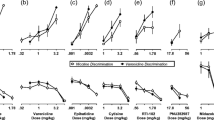Abstract
The nicotinic agonists N-(3-pyridylmethyl)pyrrolidine (PMP) and isoarecolone have been compared with (−)-nicotine in three behavioural procedures and as inhibitors of [3H]-(−)-nicotine binding. Locomotor activity was recorded as movements between beams of infra-red light (ambulation). In experimentally naive rats, nicotine, PMP and isoarecolone reduced ambulation. In rats receiving nicotine chronically and previously exposed to the activity cages, nicotine and PMP increased ambulation in a dose-related manner. However, isoarecolone did not increase ambulation at doses that were active in other procedures. In rats trained to discriminate nicotine from saline in a two-bar operant conditioning procedure with food reinforcement, there was full generalization to PMP. It was also found that PMP potently inhibited the binding of [3H]-(−)-nicotine to rat brain membranes in vitro. These results were discussed with previous data for the discriminative stimulus and ligand-binding effects of isoarecolone obtained under similar conditions. The relative potency of PMP in different behavioural procedures was similar to that of (−)-nicotine. However, isoarecolone was relatively 10 times more potent in decreasing ambulation than would have been expected from its potency in the ligand-binding and discriminative stimulus procedures. The results suggest that the pharmacodynamic action of isoarecolone differs from that of nicotine and PMP, and that it will be a useful probe in further analyses of central nicotinic mechanisms.
Similar content being viewed by others
References
Chance WT, Kallman MD, Rosecrans JA, Spencer RM (1978) A comparison of nicotine and structurally related compounds as discriminative stimuli. Br J Pharmacol 63:609–616
Clarke PBS (1984) Chronic central nicotinic blockade after a single administration of the bisquaternary ganglion-blocking drug chlorisondamine. Br J Pharmac 83:527–535
Clarke PBS (1987) Nicotine and smoking: a perspective from animal studies. Psychopharmacology 92:135–143
Clarke PBS, Kumar R (1983) The effects of nicotine on locomotor activity in non-tolerant and tolerant rats. Br J Pharmacol 78:329–337
Goldberg SR, Risner ME, Stolerman IP, Reavill C, Garcha HS (1989) Nicotine and some related compounds: effects on schedule-controlled behaviour and discriminative properties in rats. Psychopharmacology 97:295–302
Goldman D, Deneris E, Luyten W, Kochhar A, Patrick J, Heinemann S (1987) Members of a nicotinic acetylcholine receptor gene family are expressed in different regions of the mammalian central nervous system. Cell 48:965–973
Haglid F (1967) Studies on pyridine alkaloids and their analogues. Acta Pharm Suec 4:117–138
Ksir C, Hakan R, Hall DP, Kellar KJ (1985) Exposure to nicotine enhances the behavioral stimulant effect of nicotine and increases binding of [3H]acetylcholine to nicotinic receptors. Neuropharmacology 24:527–531
Lukas RJ (1989) Nicotinic acetylcholine receptor diversity: agonist binding and functional potency. Prog Brain Res 79:117–127
Morrison CF, Stephenson JA (1972) The occurrence of tolerance to a central depressant effect of nicotine. Br J Pharmacol 46:151–156
Pratt JA, Stolerman IP, Garcha HS, Giardini V, Feyerabend C (1983) Discriminative stimulus properties of nicotine: further evidence for mediation at a cholinergic receptor. Psychopharmacology 81:54–60
Reavill C, Spivak CE, Stolerman IP, Waters JA (1987) Isoarecolone can inhibit nicotine binding and produce nicotine-like discriminative stimulus effects in rats. Neuropharmacology 26:789–792
Reavill C, Jenner P, Kumar R, Stolerman IP (1988) High-affinity binding of [3H](−)-nicotine to rat brain membranes and its inhibition by analogues of nicotine. Neuropharmacology 27:235–241
Reavill C, Walther B, Stolerman IP, Testa B (1990) Behavioural and pharmacokinetic studies on nicotine, cytisine and lobeline. Neuropharmacology 29:619–624
Romano C, Goldstein A (1980) Stereospecific nicotine receptors on rat brain membranes. Science 210: 647–650
Romano C, Goldstein A, Jewell NP (1981) Characterization of the receptor mediating the nicotine discriminative stimulus. Psychopharmacology 74:310–315
Rosecrans JA, Chance WT (1977) Cholinergic and non-cholinergic aspects of the discriminative stimulus properties of nicotine. In: Lal H (ed) Discriminative stimulus properties of drugs. Plenum Press, New York, pp. 155–185
Schechter MD, Rosecrans JA (1971) Behavioral evidence for two types of cholinergic receptors in the C.N.S. Eur J Pharmacol 15:375–378
Spivak CE, Gund TM, Liang RF, Waters JA (1986) Structural and electronic requirements for potent agonists at a nicotinic receptor. Eur J Pharmacol 120:127–131
Spivak CE, Waters JA, Aronstam RS (1989) Binding of semirigid nicotinic agonists to nicotinic and muscarinic receptors. Mol Pharmacol 36:177–184
Stolerman IP (1987) Psychopharmacology of nicotine: stimulus effects and receptor mechanisms. In: Iversen LL, Iversen SD, Snyder SH (eds) Handbook of psychopharmacology, vol 19. Plenum Press, New York, pp 421–465
Stolerman IP (1990) Behavioural pharmacology of nicotine: implications for multiple brain nicotinic receptors. In: The biology of nicotine dependence. Ciba Symposium Wiley, Chichester, pp 3–16
Stolerman IP, Garcha HS (1989) Temporal factors in drug discrimination: experiments with nicotine. J Psychopharmacol 3:88–97
Stolerman IP, Reavill C (1989) Primary cholinergic and indirect dopaminergic mediation of behavioural effects of nicotine. Prog Brain Res 79:227–237
Stolerman IP, Fink R, Jarvik ME (1973) Acute and chronic tolerance to nicotine measured by activity in rats. Psychopharmacologia 30:329–342
Stolerman IP, Garcha HS, Pratt JA, Kumar R (1984) Role of training dose in discrimination of nicotine and related compounds by rats. Psychopharmacology 84:413–419
Waters JA, Spivak CE, Hermsmeier M, Yadav JS, Liang RF, Gund TM (1988) Synthesis, pharmacology, and molecular modeling studies of semirigid, nicotinic agonists. J Med Chem 31:545–554
Whiting P, Lindstrom J (1987) Purification and characterization of a nicotinic acetylcholine receptor from rat brain. Proc Natl Acad Sci USA 84:595–599
Winer BJ (1971) Statistical principles in experimental design, 2nd edn. McGraw-Hill, New York
Author information
Authors and Affiliations
Rights and permissions
About this article
Cite this article
Reavill, C., Waters, J.A., Stolerman, I.P. et al. Behavioural effects of the nicotinic agonists N-(3-pyridylmethyl)pyrrolidine and isoarecolone in rats. Psychopharmacology 102, 521–528 (1990). https://doi.org/10.1007/BF02247135
Received:
Revised:
Issue Date:
DOI: https://doi.org/10.1007/BF02247135




